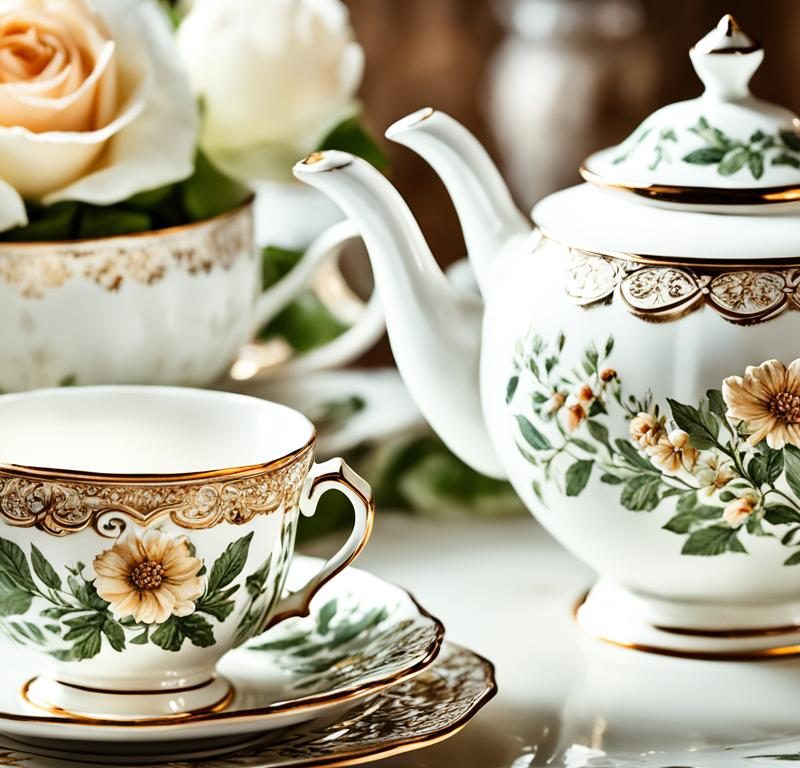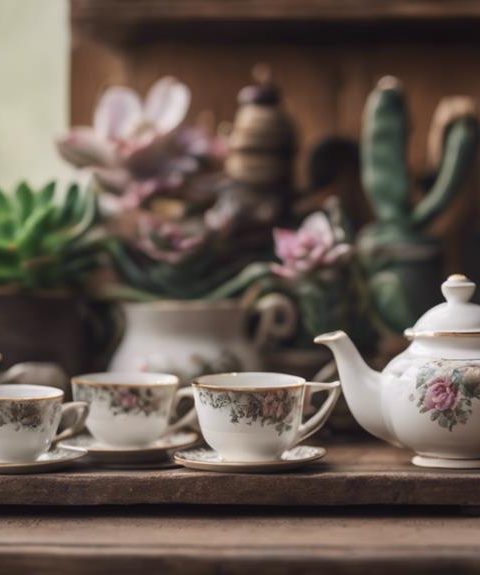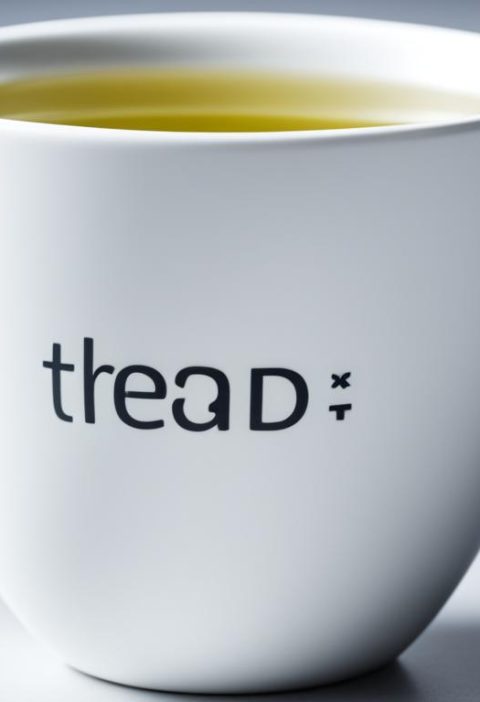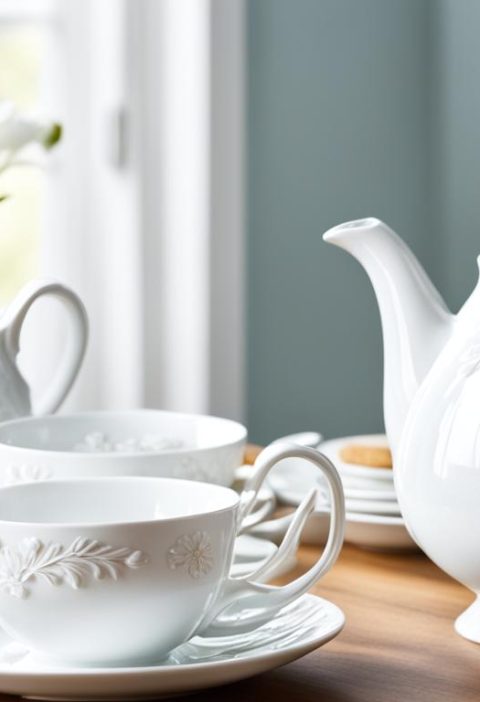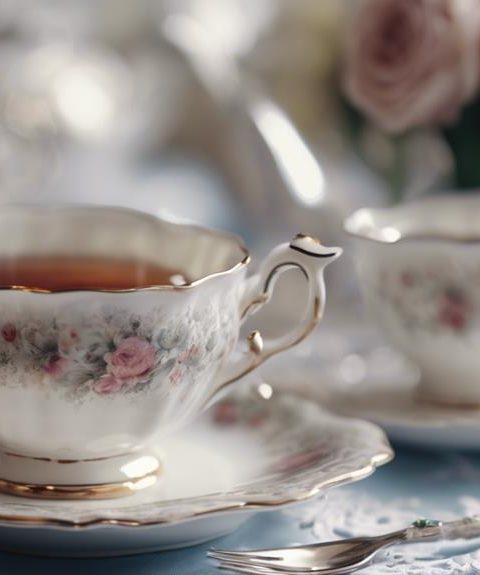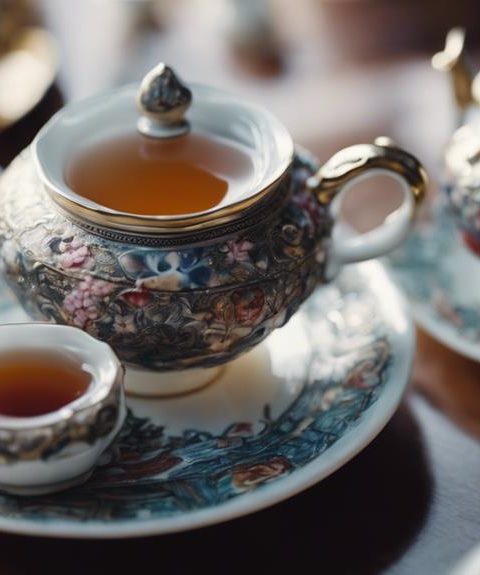Vintage tea sets are more than dishes; they hold memories and charm. They might, however, wear down or get damaged over time. This article shares how to restore them to their original beauty.
Understanding a vintage set’s worth comes first. Then, you’ll look at its condition, clean and polish it, make any needed fixes, and decide how to keep or show it. This helps keep its value and beauty alive, whether it’s a family piece or a fun find.
Understanding the Value of Vintage Tea Sets
Vintage tea sets aren’t just pretty; some can be quite valuable. The brand, age, look, and how rare it is affect its worth. Doing some research or asking an expert can tell you more about your set’s value.
Assessing the Restoration Needs
First, check your set for visible damage. It might need cleaning, fixing, or both. Cleaning can often be done gently at home. But, for repairs, you might need an expert’s touch.
Cleaning and Polishing Vintage Tea Sets
To start the restoration, you’ll often clean and polish your set. Use the right methods for the material. Porcelain might just need soap and warm water. Silver sets, on the other hand, need silver polish but must be handled with care.
Repairing and Restoring Vintage Tea Sets
Fixing a vintage set can mean many things. You may glue together broken pieces or reinforce a handle. Sometimes, you’ll need to replace missing parts or restore details. It all takes careful effort and sometimes help from professionals.
Preservation and Display of Restored Tea Sets
After restoration, work on how you’ll keep and show your set. Store it carefully and protect it from the elements. Then, choose how to display it. Whether in a cabinet or on a stand, a well-maintained set is a delight to see.
Conclusion
Restoring vintage tea sets is a craft that takes time and know-how. By understanding their value and needs, you can keep these treasures shining for many more years. Follow these tips for a successful restoration project.
Key Takeaways:
- Restoring vintage tea sets requires careful attention to detail and specialized techniques.
- Understanding the value of your vintage tea set is essential before starting the restoration process.
- Assess the condition of your vintage tea set to determine the necessary restoration services.
- Use appropriate cleaning techniques and agents to clean and polish your vintage tea set.
- Repair and restore vintage tea sets using suitable techniques and professional assistance when needed.
- Preserve and display your restored tea set in a clean and protected environment.
Understanding the Value of Vintage Tea Sets
Vintage tea sets aren’t just pretty; they can be quite valuable. Some, like collectible and antique porcelain sets, are highly sought after. The maker, how old it is, its condition, and how rare and pretty it is all matter.
Researching and seeking professional opinions is crucial. Tea sets from big names and with special designs are in high demand. This drives up their price in the vintage market.
Antique porcelain tea sets stand out for their craftsmanship and stories. How old and well-kept it is affects the price, too. A tea set that looks brand new is worth more than a damaged one.
The rareness of a tea set makes a big difference in price. So, pieces that are one-of-a-kind or hard to find cost more. Sets with unique styles or colors are also very popular with collectors.
Knowing your vintage tea set’s worth helps with decisions about repairs or selling. It brings extra joy and care to those handed-down family treasures. This is key for both collectors and those cherishing a family piece.
Factors Influencing the Value of Vintage Tea Sets:
| Factors | Description |
|---|---|
| Manufacturer | The reputation and prestige associated with the tea set’s manufacturer can significantly impact its value. Tea sets made by renowned manufacturers are often more valuable. |
| Age | The age of the tea set can contribute to its value, especially if it is from a particular era or carries historical significance. |
| Condition | The overall condition of the tea set, including any chips, cracks, or repairs, can affect its value. Well-preserved tea sets generally command higher prices. |
| Rarity | The rarity of the tea set, such as limited editions or discontinued designs, can increase its value due to the difficulty in finding similar pieces. |
| Aesthetic Appeal | The visual appeal of the tea set, including its design, patterns, and color combinations, can influence its desirability and value. |
- How can the manufacturer affect the value of a vintage tea set?
- Why does the age of a tea set matter when determining its value?
- What role does the overall condition play in the value of a vintage tea set?
- How does the rarity of a tea set affect its value?
- Why is the aesthetic appeal important in determining the value of a vintage tea set?
Assessing the Restoration Needs
Before jumping into restoring your vintage tea set, check its condition. Look for cracks, chips, discoloration, or missing parts. This check helps you figure out how much restoration your set needs.
If your set looks dirty or stained, start with a good clean. Use gentle methods and products made for delicate items. This protects your tea set while making it look better.
Fixing chipped tea cups is a common part of restoration. You can repair small chips at home. For bigger repairs, like fixing a handle, a pro might be needed. They ensure such fixes are strong and safe to use.
It’s key to really understand what your tea set needs to look perfect again. By checking it carefully, you can plan the right steps to make it shiny and new. This also keeps its value high over time.
Questions You Might Have
- How should I assess the condition of my vintage tea set?
- What should I look for when assessing damage on my tea set?
- Can I clean my vintage tea set myself?
- What products should I use to clean my tea set?
- How do I repair chipped tea cups?
- When is professional assistance necessary for tea set repair?
Common Vintage Tea Set Damages
| Damage Type | Description |
|---|---|
| Cracks | Visible lines or breaks in the tea set’s porcelain or ceramic surface. |
| Chips | Small pieces of the tea set’s porcelain or ceramic that have broken off. |
| Discoloration | Changes in the color or hue of the tea set’s surface. |
| Missing Parts | Components or decorative elements that are no longer present on the tea set. |
| Tarnish | Darkening or dullness of the surface, commonly found on silver tea sets. |
Cleaning and Polishing Vintage Tea Sets
To make a vintage tea set shine, you need to clean and polish it well. The cleaning process varies depending on the set’s material. You might own a porcelain set or a silver one, each needing different care. Here, you’ll find tips to make any set look new again.
1. Cleaning Porcelain Tea Sets
Porcelain sets need gentle care. Start by mixing mild soap with warm water. Use a soft sponge to clean, but avoid scrubbing too hard. After washing, dry it with a soft cloth. Remember, don’t use harsh cleaners or stiff brushes on porcelain.
2. Polishing Silver Tea Sets
Silver sets can get dull over time. They need silver polish to restore their luster. First, put a bit of polish on a soft cloth. Rub the silver in circles to polish it well. After polishing, rinse with warm water and dry gently. Avoid harsh scrubbing to prevent scratches.
3. Removing Tarnish from Silver Tea Sets
For heavily tarnished silver, try baking soda and water. Make a paste and apply it to the tarnished spots. Rub gently in circles. Then, rinse and dry the set. This method is great for eliminating tarnish and making the silver shine.
4. Porcelain Cleaning Methods
If porcelain stains are tough, you can try a baking soda paste. It should be thick. Spread the paste over stains and wait a few minutes. Then, use a soft toothbrush to gently scrub. Rinse thoroughly. Another trick is a lemon juice and salt mix. Apply, let it sit, then scrub and rinse.
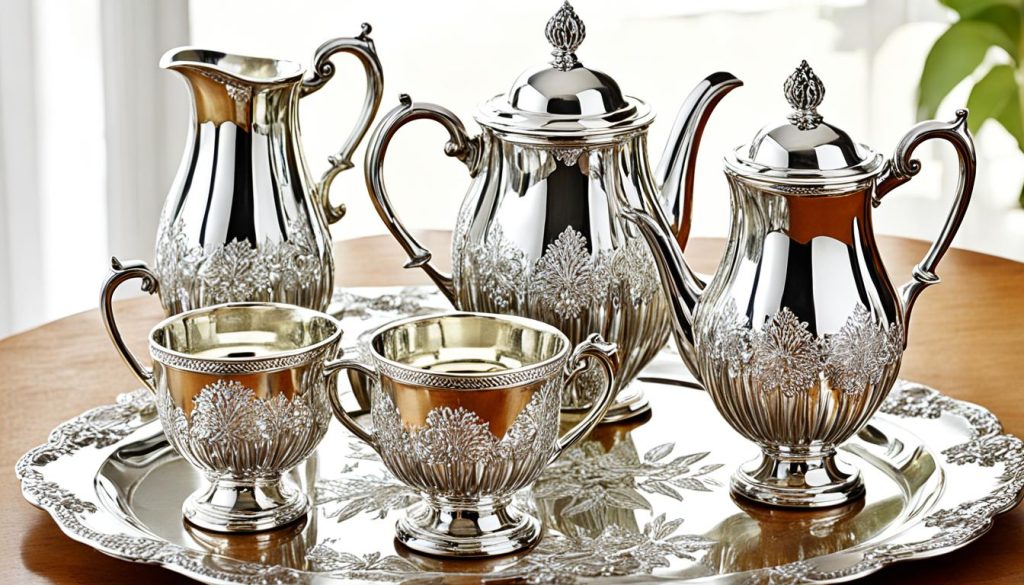
| Tea Set Material | Cleaning Technique |
|---|---|
| Porcelain | Gentle soap and warm water |
| Silver | Specialized silver polish |
| Silver (severe tarnish) | Baking soda and water paste |
| Porcelain (stubborn stains) | Baking soda and water paste or lemon juice and salt mixture |
Repairing and Restoring Vintage Tea Sets
Getting vintage tea sets back in shape might need different fixes. Fixing them, like regluing handles or fitting new parts, needs care. It often involves taking time or even getting a pro’s help.
Q: How do you fix broken tea cups or saucers?
Don’t worry if a tea cup or saucer breaks. It’s fixable with the right approach. After cleaning the broken parts, use a good glue made for ceramics. Hold them together until the glue sets. Always follow the glue’s directions for the best outcome.
Q: What can you do about loose or damaged tea pot handles?
A loose or broken tea pot handle needs a strong fix. For some materials, gluing it back can work. Make sure the glue is ceramic-safe. Or, consider a expert’s repair for a lasting fix.
Q: How can you replace missing parts in a vintage tea set?
Sometimes, parts of a vintage tea set are missing. This might be handles, lids, or decoration. Finding the right parts might need help from antique dealers or experts. They can help get or make the parts needed to complete your set.
Q: Are there any specialized techniques for ceramic tile restoration in tea sets?
Restoring tiles might be part of fixing your tea set. It involves cleaning, fixing any breaks, and resurfacing them to look new. For serious damage, pros in tile restoration could be your best bet.
To get your vintage tea set looking good again, be attentive to the damage. Use the right methods and take your time. With careful work or help from experts, you can keep enjoying your set for many more years.
Preservation and Display of Restored Tea Sets
After restoring your vintage tea set, keeping it safe is important. Use the advice here to guard your treasure. It will also make your home look very refined.
Proper Storage for Tea Set Preservation:
For long-lasting preservation, keep your tea sets clean and dry. Avoid direct sunlight. This prevents colors from fading.
Extreme temperatures can harm the set. It’s crucial to keep humidity at a moderate level. Use acid-free paper to wrap each piece. This guards against scratches and dust.
Dividers or separators help if your tea set is large. They stop pieces from getting damaged.
Display Options for Vintage Tea Sets:
Showing off your tea set can be fun. An elegant display can create a great atmosphere. Here are a few ideas:
- Choose elegant cabinets or display cases. They protect your set from dust and harm.
- Open shelves are great for easy viewings. They add charm to any space.
- Use specialized stands. They highlight your tea set’s special features.
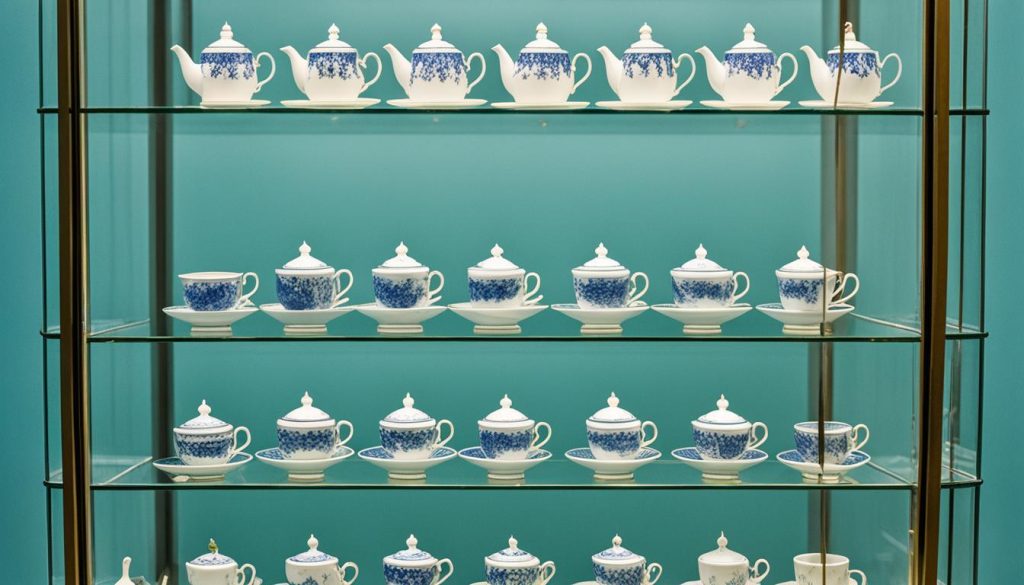
Maintaining the Beauty of Your Restored Tea Set:
Keeping your tea set clean stops dirt from damaging it. Here are some simple cleaning suggestions:
- Regularly dust your tea set using a soft cloth or a feather duster.
- Avoid harsh cleaning materials. They can scratch the set.
- If you need to wash it, use mild soap and dry it fully.
| Preservation Tips | Display Options | Maintenance Techniques |
|---|---|---|
| Storage in a clean and dry environment | Elegant cabinets or display cases | Gentle dusting and cleaning |
| Use acid-free tissue paper or soft cloth for wrapping | Open shelves for easy viewing | Avoid harsh cleaning agents |
| Avoid direct sunlight, extreme temperatures, and high humidity | Specialized tea set display stands | Clean with mild dish soap and warm water |
By taking care of your vintage tea set, it will stay beautiful for years. Show it proudly in your home.
Conclusion
Congratulations on beginning the journey to revive your vintage tea set! You’re on the right path with the correct advice and strategies. This makes expert refurbishment achievable. Preserving these heirlooms allows you to celebrate their story and cherish their elegance for many years.
Keep in mind, restoring vintage tea sets needs keen focus and a bit of expertise. Firstly, learn the worth of your set and see what needs to be fixed. This helps you plan the cleaning, fixing, and enhancing process in the best way.
It’s vital to use the right methods for cleaning and fixing, based on the material. Whether it’s porcelain or silver, the right care makes old tea sets sparkle again. Fixing and replacing parts ensures they stay strong and beautiful.
After you finish restoring your set, think about how to keep it looking stunning. Keep it away from too much heat, light, and moisture. Regularly cleaning and dusting your set helps it stay in top shape.
Reviving vintage tea sets is indeed a task full of joy and dedication. It pays off in the end. With these restoration tips, you’re set to breathe new life into these treasured heirlooms. Thus, you bring back a tradition of enjoying tea that respects its heritage.
